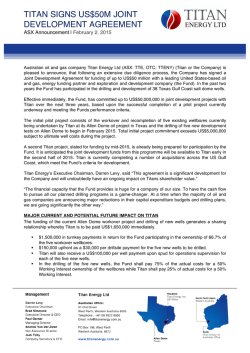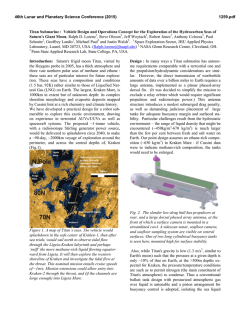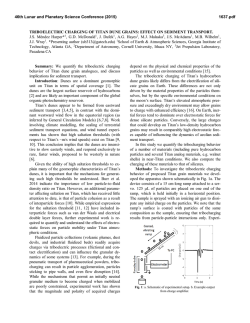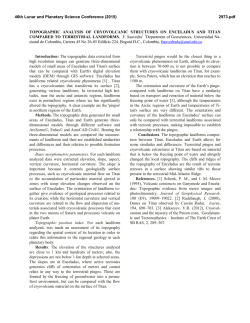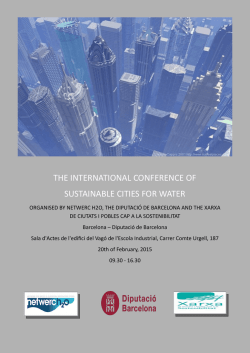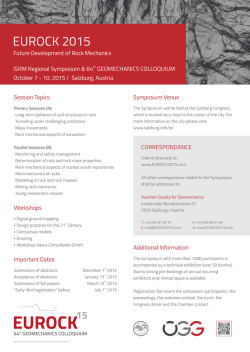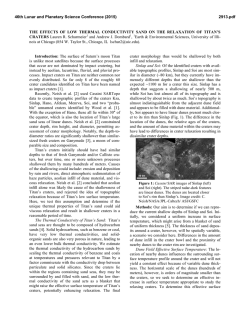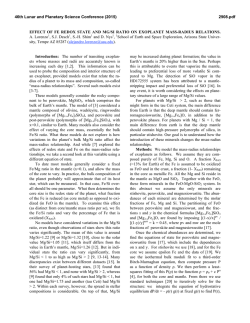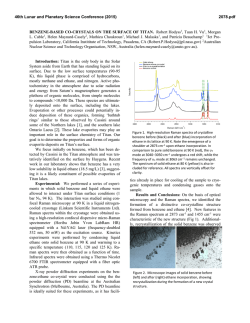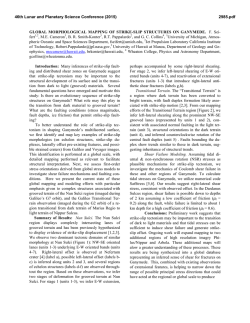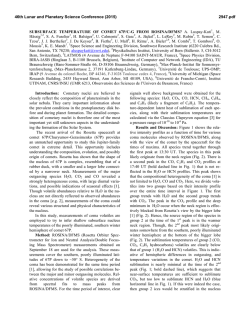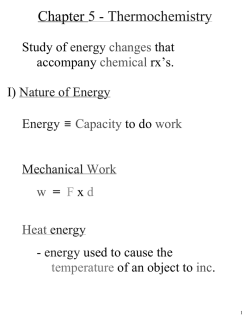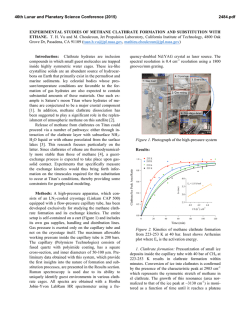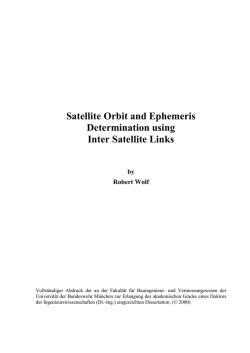
Total Rock and H
46th Lunar and Planetary Science Conference (2015) 1334.pdf TOTAL ROCK AND H2O CONTENT IN THE COMPLETELY AND PARTIALLY DIFFERENTIATED SATELLITES GANYMEDE AND TITAN. A. N. Dunaeva, V. A. Kronrod, O. L. Kuskov (Vernadsky Institute of Geochemistry and Analytical Chemistry, Russian Academy of Sciences, Kosygin Str., 19, 119991 Moscow, Russia, [email protected]). Introduction: In this paper the values of H2O (water, ice)/rock ratio in the large icy moons of Jupiter and Saturn have been examined. Models of the internal structure of the largest icy satellites, Ganymede and Titan, were considered in details. It has been shown that a model of fully differentiated Ganymede, as well as a model of the partially differentiated Titan (Titan with a rock-ice mantle), are in a good agreement with available theories of the satellites’ formation and evolution in Jupiter and Saturn accretion discs. These models provide the ice/rock ratio in the satellites close to 1. Alternative models of the fully differentiated Titan in which a complete separation of rock from ice occurres, were considered as well. The total H2O content in Titan derived from these models is found to be substantially lower, than that obtained for abovedescribed models and gives the lower ice/rock ratio equal to 0.5-0.6. Problem description and results: In general case the satellites Ganymede and Titan are described by three-layer models including: 1) the outermost waterice shell (high pressure ices water internal ocean with any salt composition), 2) the central rock-iron or FeFeS core and 3) intermediate mantle [1-5]. Depending on a chosen satellite and corresponding model the mantle is assumed to be composed of either anhydrous [13] or hydrous silicates (serpentine, antigorite) [4], or ice-rock homogeneous mixture [5]. Furthermore, in recent papers devoted to Titan's researches the intermediate mantle is excluded from satellite’s structure and Titan is thought to consists only of two layers outer H2O-shell and inner rock-iron core [6-8]. In this paper various models of the icy satellites Ganymede and Titan were built on the base of our previously developed approaches [1-2, 5]. In these models we additionally estimated the heterogeneity of the satellites’ interiors which can be due to a change of phase composition within a local structural layer or owing to the substance's density change with depth. To do this, a special subroutine which includes equations of state of all H2O phases, silicate and hydrous silicate minerals, and also a special procedure describing the convective regime in mantle's reservoir were developed. This allowed us to calculate in a more detailed way the density of the satellite's substance in changing P-T conditions, to improve the boundaries between the structural zones, as well as estimate the H2O content in the waterice-containing interiors of satellites. Internal structure of Ganymede. Based on a large number of theoretical works, Ganymede can be considered as a completely differentiated satellite in which the outer water-ice shell with an internal ocean, silicate mantle and the central Fe-FeS core were fully separated [1-2]. Using revised data on the physical characteristics of Ganymede (R=2631.2 km, ρ = 1942.0 kg/m3, I/MR2=0.312), and the value of the satellite’s heat flux ~5 mW/m2 the Ganymede's internal structure was recalculated. The values of Fe-FeS core density were chosen in the range of 5.15-6.50 g/cm3. When calculating, we additionally estimated the progressive change in the mantle density with depth in accordance with the equations of state of silicates [4]. The results of calculations showed that the radius of Ganymede’s central Fe-FeS core does not exceed a value of 630-760 km. The maximum thickness of the outer water-ice shell is about 910 km (100 km of Ih-icy crust + 200 km of water internal ocean + 50 km of ice V + ice VI). The density of the mantle’s silicates under standard conditions was determined from calculations, and it was found to be equal to 3.15-3.50 g/cm3, which is in a close agreement with the density of ordinary L/LL chondrites. According to silicates equations of state, the mantles density varies with depth between 3.19 and 3.74 g/cm3. The total H2O content in Ganymede is estimated as 43.3-50.4% which is slightly lower than our previous assessments [1] and corresponds to the satellite’s ice/rock ratio of 0.8 – 1.0. Internal structure of Titan. There are two competitive models of the internal structure of Saturn's icy moon, Titan: 1) models of partially differentiated satellite, with a large internal region composed by homogeneous rock and ice mixture (rock-ice mantle) [5], and 2) models of fully differentiated Titan. The second group includes both the three-layered Titan's models, where the satellite contains an intermediate mantle composed of hydrous minerals (Ganymede's like structure) [3, 4] and the two-layered satellite's models consisting of a H2O-shell with complicated composition (outermost Ih-ice lid, dense liquid ocean with dissolved salts, underlying high pressure water ices) and inner rocky core [6-8]. The model of Titan with undifferentiated rock-ice mantle was thoroughly investigated in [5]. The main calculation results for this model are as follows: 1) The 46th Lunar and Planetary Science Conference (2015) large Jupiter and Saturn satellites (Fig.1). Reported differences in the Titan's total H2O content obtained from different models apparently leads to different hypotheses of the satellite formation. In this case the ice/rock ratio can be used as a geochemical marker of the correctness of a chosen model. 60 0 10 20 30 40 50 60 70 80 90 100 Iapetus Saturnian system RSat. 50 40 30 Orbital distance (in Rplanet) maximum thickness of the satellite’s water-ice shell is 450-470 km. The maximum size of the central rocky core is 1300 km.; 2) The density of rock-ice mantle is about 1.22-2.64 g/cm3 with the H2O content of 2470%; 3) The total H2O content in Titan is 45-51% (ice/rock ratio is close to 1), which is similar to Ganymede and Callisto (49-55%) [1-2, 5], (Fig. 1). The main calculation results for the Titan’s model with hydrous silicate mantle indicate that the maximum thickness of the water-ice shell is 430-480 km, and maximum size of the central Fe-Si core is 930 km. The H2O content of Titan's hydrated mantle was taken as 13% - typical value for serpentine group minerals. This assumption led to the related estimates of the bulk amount of H2O in Titan as 35-38% (Fig. 1, red color), which reflect the H2O/rock ratio in the satellite equal to 0.5-0.6. The 2-layered model of the Titan internal structure is a particular case of the previous three-layered satellite‘s model with the largest thikness of water-ice shell (480 km) and smallest size of inner rocky core (up to its complete absence). In this case the outer H2O-shell is underlain by the large layer of hydrous silicate substance extended up to the satellite’s center. The reference density of this substance at the standart conditions is 2.44 g/cm3 and it varies with depth in the interval 2.47-2.65 g/cm3. In view of the substance hydration, the H2O/rock ratio in the satellite from this model does not exceed 0.6. Conclusions: Revealed features of the Ganymede and Titan internal structures, as well as their bulk amount of H2O, calculated from different models, should reflect the specific conditions of the satellites’ formation and evolution. Our results have shown that the internal structure and composition of Ganymede is consistent with the theory of regular satellites’ formation in the Jovian accretion disk, according to which Ganymede was formed in the relatively warm subnebula ~250 K during 103-104 yrs [9] - the shortest accretion time compared to Callisto and Titan. This led to the fact that Ganymede could heat up sufficiently for melting its inner layers and following differentiation. It is likely that Titan was formed during ~106 yrs at lower temperatures 60–90 K in the saturnian accretion disk [10]. This has lead to incomplete differentiation of the satellite, conforming to the Titan’s model with ice-rock mantle. It should also be noted that in a fully differentiated Ganymede and in a partially differentiated Titan the H2O ice/rock ratio is close to 1. This value agrees well with ice/rock ratio 1.17 expected from cosmic abundances of H2O-ice and rock [11]. On the contrary, in a fully differentiated Titan the H2O content is found to be more than 10% lower than the values typical for all 1334.pdf Titan 20 Dione Enceladus 10 Rhea Tethys Mimas 0 30 RJup. Jovian system Callisto 25 20 Ganymede 15 Europa 10 Io 5 0 10 20 30 40 50 60 70 80 90 100 H 2O, wt % Figure 1: H2O content in the icy satellites of Jupiter and Saturn [1-2, 5, 12]. The red symbol indicates the models of Titan with hydrous silicate mantle (13 wt % H2O). Shaded area shows the area in which the ice/rock ratio values in satellites are close to 1. This research was supported by the Russian Academy of Sciences under Program 22 and by the RFBR grant 15-05-02572. References: [1] Kuskov O. L. and Kronrod V. A. (2001) Icarus, 151, 204–227. [2] Kuskov O. L. and Kronrod V. A. (2005) Icarus, 177, 550–569. [3] Castillo-Rogez J. and Lunine J. (2010) JGR, 37, L20205. [4] Fortes A. (2012) Planet. Space Sci., 60, 10–17. [5] Dunaeva A. N. et al. (2014) Dokl. Earth Sci., 454, 89– 93. [6] Sohl F. et al. (2014) JGR, 119, 1013–1036. [7] Baland R.-M. et al. (2014) Icarus, 237, 29–41. [8] Lefevre A. et al. (2014) Icarus, 237, 16–28. [9] Mosqueira I. and Estrada P. R. (2003) Icarus, 163, 198231. [10] Makalkin A. B. and Dorofeeva V. A. (2014) Solar Syst. Res., 48, 62–78. [11] Lodders K. (2003) Astrophys. J. 591, 1220–1247. [12] Sekine Y. and Genda H. (2012) Planet. Space Sci., 63-64, 133-138.
© Copyright 2025
